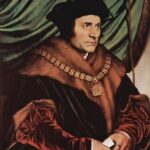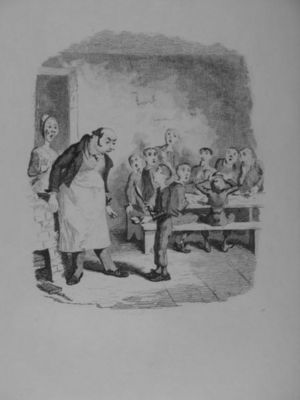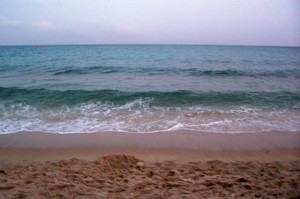Loathe him or love him, see him as villain or hero, Oliver Cromwell played a part in English history that had a lasting significance. But who were the Cromwells?
When Oliver Cromwell was born in 1599, the Cromwells were important landowners. Oliver’s father, Robert Cromwell, was the second son of Sir Henry Cromwell (the Golden Knight), who had inherited his estates from his father, Richard, who was the nephew of Thomas Cromwell, chief minister of Henry VIII in the 1530s.
The family’s wealth was acquired from monastic estates when Henry VIII dissolved the monasteries during the early stages of the English Reformation. Sir Oliver Cromwell, Cromwell’s uncle inherited Hinchingbrooke near Huntingdon, Cambridge shire (formerly Huntingdon shire). Whilst living at Hinchingbrooke he lived extravagantly and entertained both Queen Elizabeth I and King James but in 1627 Sir Oliver was forced to sell Hinchingbrooke to pay off his debts.
Oliver Cromwell’s father was a minor gentleman who owned a house and other properties in Huntingdon. He was prominent in local affairs and in 1593 served as a Member of parliament for the town. He and his wife, Elizabeth, had 10 children, 3 boys and 7 girls. Oliver was the only son to survive infancy.
Oliver Cromwell attended the Huntingdon Grammar School where he was instructed in English Grammar, Latin, Greek and arithmetic by Dr. Thomas Beard. Beard was a puritan and it is thought that it was his Puritanism which shaped Cromwell’s own deeply held beliefs.
It was in 1616, 2 days before his 17th birthday, that Cromwell was admitted to the Sidney Sussex College, Cambridge. His college career was a short one as he left after just one year due to the death of his father. But in those days not many gentleman completed college and gained a degree.
Back in Huntingdon Cromwell met and married Elizabeth Bourchier. He settled down to farming and raising his family. 1628 saw Cromwell following in his father’s footsteps and becoming the Member of Parliament for Huntingdon. Immediately he associated himself with protests against Charles I for raising taxes without reference to Parliament. During the years between 1629 and 1640 no parliament was summoned so Cromwell kept himself busy with local politics.
In 1630 there was a new Huntingdon charter which limited participation in government of the town. Needless to say this displeased Cromwell who shortly after sold his Huntingdon interests and moved to nearby St Ives where he rented land to farm.
In 1636 Cromwell moved his family again, this time to Ely where he had inherited property from his uncle, Sir Thomas Steward. Whilst at Ely he fought against schemes of fen drainage because the submitted proposals paid little attention to the interests of small local farmers and laborers. Because of this he drew a lot of local support which would do him well in the years to come.
King Charles I summoned parliament again in 1640 after a long interval of 11 years. Cromwell was elected as Member of Parliament for the Borough of Cambridge and sat in the short Parliament in the spring and in the Parliament which met in November. After that he sat continuously in Parliament until11653 which today is referred to as the ‘Long parliament’.
Cromwell was a religious man who believed deeply in a God whose hand was behind every event and who intervened directly to determine the affairs of man. Historians have labeled him a Puritan. Puritans were opposed to Roman Catholicism and wanted more doctrinal teaching in the churches and less emphasis on ceremony.
During the years 1641 and 1642 leading Members of Parliament made an attempt to remove abuses and to institute reforms in both Church and State. This began the mistrust of certain Parliament leaders and the King and it eventually developed into the Civil War which King Charles I started by raising his standard at Nottingham on 22nd August 1642.
The following years
1642 – Cromwell seized the powder store at Cambridge castle and in late August formed a troop of horses in the area.
1643 – In a successful attempt by Parliament to combine forces of the East Anglian and East Midland counties into one unit Cromwell was appointed a Colonel in the army of the Eastern Association. During much of the war, London, the South-East and East Anglia were mainly Parliamentarian whilst the North, the West and Wales were Royalist. It was during engagements in Lincolnshire , Grantham, Gainsborough and Winceby that Cromwell proved over again his skill as a commander.
1644 – Cromwell was promoted to Lieutenant-General and took part in the Battle of Marston Moor, near York. His role here was decisive in the defeat of the Royalists.
1645– Several Parliamentary forces were joined to form the New Model Army under the command of Sir Thomas Fairfax. Cromwell was appointed Lieutenant -General in charge of Cavalry in the New Army. In June of 1645 the New Model Army won a major victory over the Royalists at Naseby in Northamptonshire.
1646 – King Charles surrendered at Newark to the Scots who had been Parliamentarian allies since 1643. At this point Cromwell moved his family to London.
1646-47 – Attempts to reach a settlement between Parliament and the King continued but without success. Cromwell and the army became more involved in politics and there were many disagreements within the Army and the Parliamentary side broke into factions. This gave Charles I hope that he could gain from the division and dissent.
1647-1649 – In December 1647 Charles I made an alliance with the Scots conceding demands for a strict religious settlement in England in exchange for their invasion of England on his behalf. Cromwell and the New Army ended this second Civil War when they defeated the Scottish Royalist Army on 17th August 1648 at Preston. After Charles I rejected a final attempt at a peaceful settlement Cromwell agreed to setting up a court to try him. Charles refused to plead and was executed at Whitehall on 3rd January 1649.
A republic was established of which the Commons were the body and the House of Lords was abolished.
1649-1653 – Cromwell was made Lord Lieutenant of Ireland and Commander in Chief of an expedition to reassert English control over the Irish Catholic population. Charles I son gained support in Scotland after his father’s execution and Cromwell returned to England to lead an army against him. Cromwell’s senior officer Fairfax refused to attack Scotland and in June 1650 Cromwell replaced him as Commander in Chief of the Forces of the Commonwealth. September 1650 saw the Scots being defeated at Dunbar and again a year later at Worcester. Charles Stuart just narrowly escaped.
Despite these successes tension still abounded between the radicals and those seeking stability. Cromwell eventually called in his troops to dissolve the remaining Rump of the Long Parliament. The army leaders chose an assembly to replace it but it failed to unite and by the end of the year the moderate elements voted to end the Parliament and to give their power to Cromwell.
On 16th December 1653 Oliver Cromwell was installed as Lord Protector. The Royal Palaces of Whitehall and Hampton Court became the home of the Cromwell family. During the following 9 months over 80 ordinances or decrees were issued covering religious, moral and political affairs.
There were several assassination plots uncovered against Cromwell and anxious to ensure stability a new Parliament met in September 1656 and proposed the Humble Petition and Advice. This was a new constitution by which Oliver Cromwell would become King but Cromwell refused the title.
In 1658 Cromwell fell ill and the lengthy illness of his favorite daughter, Elizabeth Claypile, and her death on 6th August 1658 led to his complete collapse. Cromwell was too grief stricken to attend her funeral. Cromwell’s condition worsened on the evening of 17th August 1658 but after recovering briefly he had a relapse in September. He gave affirmation that his son Richard was to succeed him on the 2nd September dying early afternoon on 3rd September 1658.
1658-1660 – After succeeding his father Richard Cromwell faced the same problems and May of 1659 saw the Rump of the Long Parliament being recalled and Richard abdicated. During the next 12 months there was political chaos and turmoil and the way for Charles Stuart to return was prepared.
Charles II was proclaimed King in May 1660 and the monarchy was restored without any of the restrictions which Parliament had tried to impose on Charles I.
At this point it needs noting that the restoration was achieved by elements in the Army and Parliament rather than by the efforts of diehard Royalists.
Cromwellian Sites in Cambridgeshire
Huntingdon – Hinchingbrooke House which was owned by Cromwell’s Grandfather and which remained in the Cromwell family until 1627 after being acquired at the Dissolution in 1538. Although used as a school it is open to the public on a regular basis on Sunday afternoons between April and August.
Ramsey – Ramsey Abbey was another former Cromwell house and after the sale of Hinchingbrooke House it became the main home of Cromwell’s uncle, Sir Oliver.
St Ives – Cromwell lived here from 1630 to 1636. His home is no longer standing but the parish Church which he attended does and is well worth a visit. In St Ives Market Place there is a fine statue of Cromwell which was unveiled in 1901.
Ely – Cromwell was Governor for the isle of Ely from 1643 and his home is now much restored and stands to the west of the Cathedral where he worshipped. Cromwell House is open to the public and has an exhibition about his life and times recreating some domestic scenes.
Source
The Cromwell Museum by Cambridgeshire County Council




